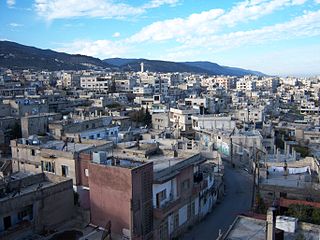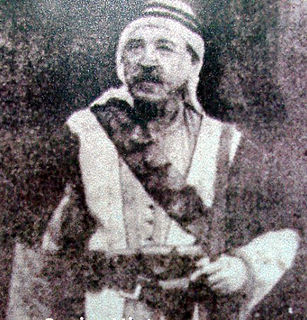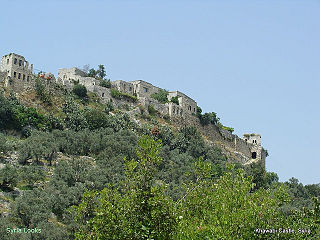| Aqir Zayti عقر زيتي Aqir Zeit | |
|---|---|
| Village | |
| Coordinates: 34°57′43″N36°0′23″E / 34.96194°N 36.00639°E Coordinates: 34°57′43″N36°0′23″E / 34.96194°N 36.00639°E | |
| Country | |
| Governorate | Tartus |
| District | Tartus |
| Subdistrict | al-Sawda |
| Population (2004) | |
| • Total | 783 |
| Time zone | EET (UTC+2) |
| • Summer (DST) | EEST (UTC+3) |
| City Qrya Pcode | C3409 |
Aqir Zayti (Arabic : عقر زيتي, also spelled Aqir Zayt or Aqir Zeit) is a village in northwestern Syria, administratively part of the Tartus Governorate, located in the Syrian Coastal Mountain Range, east of Tartus. The village of Khirbet al-Faras is located immediately south. According to the Syria Central Bureau of Statistics (CBS), Aqir Zayti had a population of 783 in the 2004 census. [1] Its inhabitants are predominantly Ismailis, who moved there after being forced out from the nearby fortress village of Khawabi in the early 20th century. [2]

Syria, officially the Syrian Arab Republic, is a country in Western Asia, bordering Lebanon to the southwest, the Mediterranean Sea to the west, Turkey to the north, Iraq to the east, Jordan to the south, and Israel to the southwest. A country of fertile plains, high mountains, and deserts, Syria is home to diverse ethnic and religious groups, including Syrian Arabs, Greeks, Armenians, Assyrians, Kurds, Circassians, Mandeans and Turks. Religious groups include Sunnis, Christians, Alawites, Druze, Isma'ilis, Mandeans, Shiites, Salafis, Yazidis, and Jews. Sunni make up the largest religious group in Syria.

Tartus Governorate is one of the fourteen governorates (provinces) of Syria. It is situated in western Syria, bordering Lebanon to the south, the Mediterranean Sea to the west, Latakia Governorate to the north, and Homs and Hama Governorates to the east. It is one of the few governorates in Syria that has an Alawite majority. Sources list the area as 1,890 km² or 1,892 km². The governorate has a population of 785,000. The capital is Tartus.

The Coastal Mountain Range is a mountain range in northwestern Syria running north-south, parallel to the coastal plain. The mountains have an average width of 32 kilometres (20 mi), and their average peak elevation is just over 1,200 metres (3,900 ft) with the highest peak, Nabi Yunis, reaching 1,562 metres (5,125 ft), east of Latakia. In the north the average height declines to 900 metres (3,000 ft), and to 600 metres (2,000 ft) in the south.
Aqir Zayti contains the al-Hajj Khidr Tomb, an important Ismaili shrine. According to local Ismaili legend, which is partly rooted in historical facts, al-Hajj Khidr was an Ismaili religious sheikh from al-Qadmus who became popular in that area and was consequently forced by that town's Ismaili emirs. Al-Hajj Khidr later represented the Ismaili community of Khawabi, where he and his supporters took refuge, on a delegation to meet the chief imam of the Ismailis in India. The imam in India assigned al-Hajj Khidr to become the chief missionary of Syria, replacing the aging Muhammad al-Suwaydani. Upon returning to Syria, al-Hajj Khidr's authority was rejected by the Ismaili emirs of al-Qadmus, Masyaf and Wadi al-Uyun. The two sides later clashes and al-Hajj Khidr and many of his partisans were killed. [3] Due to reforms by Aga Khan III which forbade shrine worship, al-Hajj Khidr's shrine was dismantled in the early 20th century. [4]

Al-Qadmus is a town in northwestern Syria, administratively part of the Tartus Governorate, located northeast of Tartus and 14 kilometres southeast of Baniyas. Nearby localities include Kaff al-Jaa and Masyaf to the east, Wadi al-'Uyun and al-Shaykh Badr to the south, Hammam Wasel, al-Qamsiyah and Maten al-Sahel to the southwest, Taanita to the west, al-Annazeh to the northwest and Deir Mama to the northeast. It is situated just east of the Mediterranean coast and its ruined castle stands on a plateau roughly 850 metres above sea level and just above the town.

Imam is an Islamic leadership position.

India, also known as the Republic of India, is a country in South Asia. It is the seventh largest country by area and with more than 1.3 billion people, it is the second most populous country as well as the most populous democracy in the world. Bounded by the Indian Ocean on the south, the Arabian Sea on the southwest, and the Bay of Bengal on the southeast, it shares land borders with Pakistan to the west; China, Nepal, and Bhutan to the northeast; and Bangladesh and Myanmar to the east. In the Indian Ocean, India is in the vicinity of Sri Lanka and the Maldives, while its Andaman and Nicobar Islands share a maritime border with Thailand and Indonesia.










